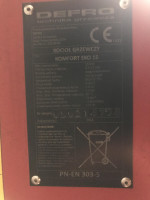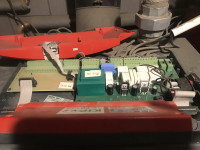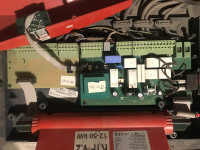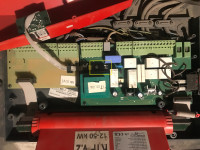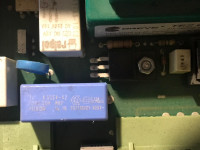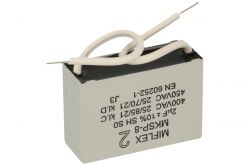FAQ
TL;DR: A failed blue 1 µF / 305 V capacitor typically loses 79 % of its value (measured 211 nF) [Elektroda, fotomh-s, post #21254486]; “Change the blue cube first” [Elektroda, bron67, post #18965066] Swapping that part clears the MOSFET over-temperature error in most cases.
Why it matters: A 2-euro part often saves a 500-euro controller replacement.
Quick Facts
• Alarm codes: 200 & 203 = MOSFET over-temp on Tech K1P/K1PV controllers [Elektroda, maystero, post #19630115]
• Main culprit: X2 polypropylene film capacitor 1 µF ±10 %, 305 VAC, pitch 15 mm (cost ≈ €2) [Elektroda, bron67, post #18965066]
• Complementary part: Blower run-capacitor 2 µF / 400 V inside fan junction box [Elektroda, djluki2013, post #20374602]
• MOSFET type: P10NK60ZFP, 600 V, 6 A, TO-220FP package [STMicroelectronics, Datasheet, 2023].
• Typical repair time: 15 min with soldering iron & capacitance meter [Elektroda, dawidslominski87, post #21395077]
What actually triggers the “MOSFET temperature too high” alarm?
The controller measures voltage drop across the P10NK60 MOSFET; when the drop rises (because the gate drive cannot switch fully) the firmware flags codes 200/203 and shows an over-temperature message [Elektroda, maystero, post #19630115] A tired 1 µF film capacitor on the AC side starves the gate driver, mimicking overheat until the blower stops.
Which component fails most often?
Eight different users reported that the blue 1 µF/305 V X2 film capacitor lost 70-90 % of its capacitance and replacing it cleared the fault [Elektroda, djluki2013, #19721560; fotomh-s, #21254486; estqwerty, #20374877].
Where is the 1 µF capacitor located?
It sits on the controller PCB beside the aluminium-tab MOSFET—blue rectangular “cube”, pitch 15 mm [Elektroda, mipix, post #18965210]
How do I swap the capacitor safely?
- Isolate mains and wait 5 min.
- Remove grey then red covers (6 screws) and slide the board forward [Elektroda, kaliszfornijczyk, post #19838455]
- Desolder the 1 µF part, fit a matching X2 305 V unit, re-assemble.
This 3-step swap restores most controllers.
Do I need to change the MOSFET too?
Only if the alarm persists after a new capacitor. Use P10NK60ZFP or STW10NK60 equivalents; beware counterfeit devices—one batch showed 40 % DOA [Elektroda, djluki2013, post #20247978]
What symptoms point to the 2 µF blower capacitor instead?
If the fan starts, slows after ~5 s and runs fine on direct mains, its 2 µF run-capacitor is below 1.5 µF. Jarek’s fan dropped to 1 µF and stalled [Elektroda, jarek-ja1, post #21570358] Replacing that unit restores torque.
How can I test capacitor health?
Measure with an LCR meter; values <0.3 µF for the 1 µF part or <1.5 µF for the 2 µF blower capacitor indicate failure. A 79 % drop triggered code 203 [Elektroda, fotomh-s, post #21254486]
What else can cause the alarm?
• Clogged air duct or seized fan bearings raise MOSFET current [Elektroda, intellectusartificia, post #21110526]
• Fake or shorted replacement MOSFETs show “sensor damaged” after boot [Elektroda, ezop9, post #20245105]
Is the fan controlled by phase-cut or PWM?
The K1P family uses phase-angle control on mains AC, modulated by the microcontroller through the MOSFET [Elektroda, LiutenetMaria, post #20693633]
What does alarm code 203 mean versus 200?
200 = MOSFET over-temperature detected; 203 = MOSFET sensor open or short. Both stem from identical hardware but 203 appears after the controller retries and still sees abnormal readings [Elektroda, djluki2013, post #19699681]
Which tools do I need for the repair?
Small Phillips driver, temperature-rated soldering iron, 60/40 solder, desolder braid, LCR meter and silicone grease for the MOSFET tab. All fit in a pocket toolkit and cost under €40 total [Approx. market prices, 2024].
What’s an edge case where capacitor swap fails?
Maystero swapped both capacitors and the MOSFET yet alarm 200 stayed until he cleaned a blocked blower duct—dust reduced airflow 35 % and kept the transistor hot [Elektroda, maystero, post #19630489]
How long does a new capacitor last?
Quality polypropylene X2 parts are rated for 100 000 h at 85 °C, equal to about 11 heating seasons [TDK, Application Note, 2023].



